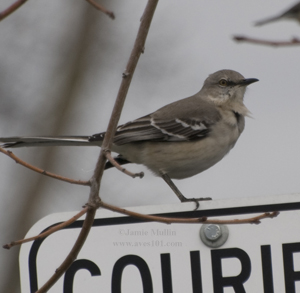Northern Mockingbird
Order: Passeriformes
Family: Mimidae
Genus: Mimus
Species: polyglottos
**Northern Mockingbird Audio Below**
**This audio clip is ~4 minutes long so I have added a pause feature to the controls below. The Mockingbirds call is made up of regimented series of phrases with each phrase being repeated two to six times. Many of the phrases are imitations of other bird species, insects or even human driven objects. I have edited this audio so that each phrase is only repeated 3-4 times and I have also done my best to ensure that there are no two repeated phrases alike throughout this segment.**
Description
-
Length: 10"
-
Wing span: 14"
-
Weight: 1.7 oz (49 grams)
-
Medium sized songbird
-
Pale gray above, whitish below and thin bill
-
In flight wings show large white wingpatches, not in flight shows two narrow white wingbars
-
White outer tail feathers
-
Sexes look alike
-
Juvenile very similar to adult but with faint spots on the breast
Factoids:
-
The "American nightingale," the Northern Mockingbird is known for its long, complex songs that include imitations of many other birds. It is a common bird of hedgerows and suburbs, and has been slowly expanding its range northward
- The Northern Mockingbird frequently gives a "wing flash" display, where it half or fully opens its wings in jerky intermediate steps, showing off the big white patches. No one knows why it does this behavior, but some have suggested that it startles insects into revealing themselves. However, it does not appear to flush insects, and other mockingbird species that do not have white wing patches use the display, casting doubt on this idea.
- The Northern Mockingbird is a loud and persistent singer. It sings all through the day, and often into the night. Most nocturnal singers are unmated males, which sing more than mated males during the day too. Nighttime singing is more common during the full moon. In well-lit areas around people, even mated males may sing at night
- A Northern Mockingbird continues to add new sounds to its song repertoire throughout its life
- The Northern Mockingbird typically sings throughout most of the year, from February through August, and again from September to early November. A male may have two distinct repertoires of songs: one for spring and another for fall. One study found only a one percent overlap in song types used in spring and fall.
- The female Northern Mockingbird sings too, although usually more quietly than the male does. She rarely sings in the summer, usually only when the male is away from the territory. She sings more in the fall, perhaps to establish a winter territory.
All photographs and audio clips are ©Jamie Mullin 2006
Sources: Cornell Lab of Ornithology & The Sibley Guide to Birds.
 |
|---|
 |
 |